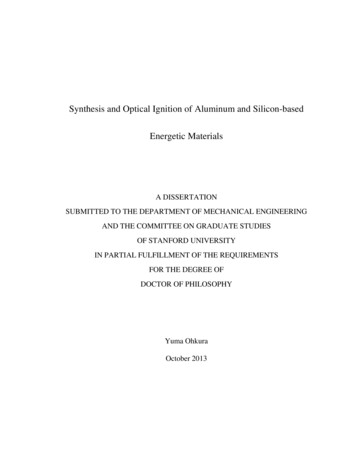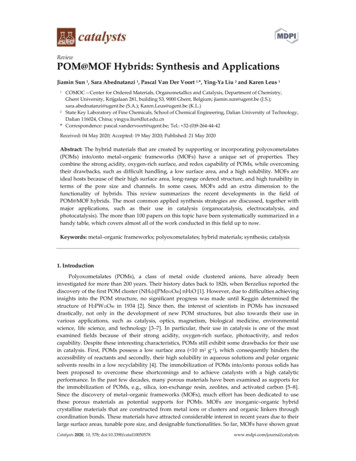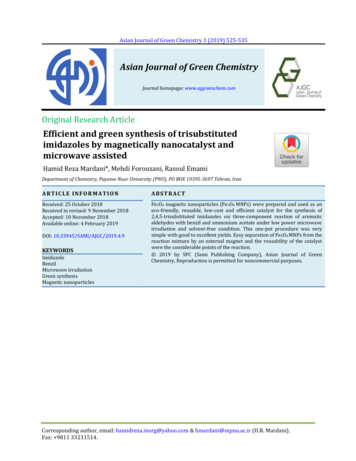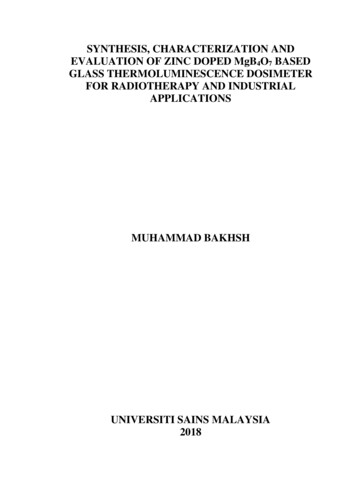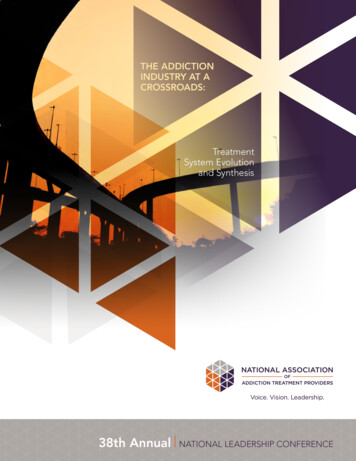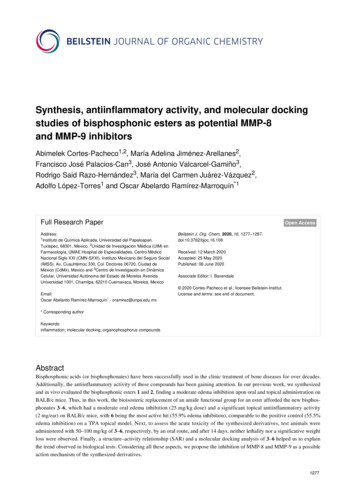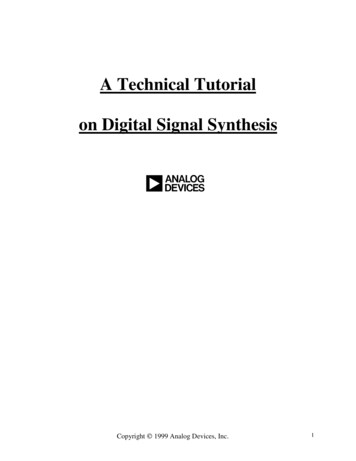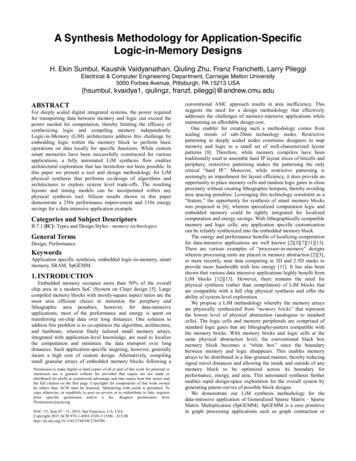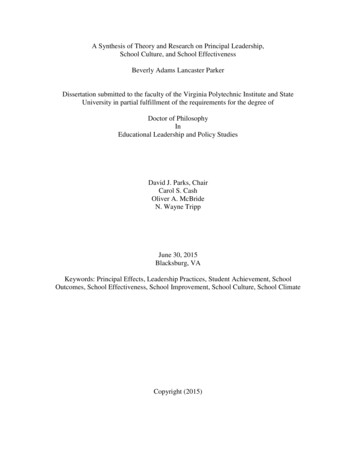
Transcription
A Synthesis of Theory and Research on Principal Leadership,School Culture, and School EffectivenessBeverly Adams Lancaster ParkerDissertation submitted to the faculty of the Virginia Polytechnic Institute and StateUniversity in partial fulfillment of the requirements for the degree ofDoctor of PhilosophyInEducational Leadership and Policy StudiesDavid J. Parks, ChairCarol S. CashOliver A. McBrideN. Wayne TrippJune 30, 2015Blacksburg, VAKeywords: Principal Effects, Leadership Practices, Student Achievement, SchoolOutcomes, School Effectiveness, School Improvement, School Culture, School ClimateCopyright (2015)
A Synthesis of Theory and Research on Principal Leadership,School Culture, and School EffectivenessBeverly Adams Lancaster ParkerABSTRACTThe national push for increased accountability, the demand for academicachievement for all students, as defined by high-stakes testing, and sanctions imposed onpublic schools create significant challenges for the school principal. The principal ischarged with leading improvement efforts to improve student achievement and schooleffectiveness. Striving for excellence is a collaborative, inquiry-based quest, in which theprincipal must engage all stakeholders in the development of a productive learningculture designed to improve teaching and learning. To do this, educational practitionersmust glean and use improvement strategies from well-grounded theory, educationalresearch, best practices, and evidence-based decision making.This study is an investigation and synthesis of the relationships among leadershipbehaviors, school culture, and school outcomes, including student achievement, in aneffort to determine direct and indirect effects. It is based on the premise that schoolleadership has a direct effect on school culture, and school culture has a direct effect onschool effectiveness, including student achievement. Schein’s model of culture wasselected as the operational definition of culture. The concept of school climate is basedon environmental factors and is included within the larger concept of school culture.The resulting work is the development of a theory of school effectiveness, basedon a review of educational research, theory, and best practices synthesized from multiple
studies. The work is intended to serve as a resource for those involved in schoolleadership and school improvement efforts.Evidence for supporting direct effects of leadership on school effectiveness,including student achievement is very limited in the literature. However, results indicatethat the principal does have a direct effect on school culture and climate through strategicintervention strategies and behaviors. A review of studies examining the relationshipsbetween school culture and student achievement indicate that there is a significantmoderate effect between school culture and student achievement in K-12 public schoolsin the United States. Although there remains limited evidence that the school principaldirectly affects student achievement, there is sufficient evidence to indicate that schoolculture is a significant mediating factor between principal leadership and schooleffectiveness.iii
DEDICATIONThis dissertation is dedicated to my precious family who has provided me withendless love, support, encouragement, and understanding during this process. They neverallowed me to give up, even during my greatest challenges and struggles. To my children,whether by birth, step, or in-law: John, Robin, Claire, Michael, for your ceaseless love,encouraging texts, and patience needed to keep me going. To my little princessgranddaughter, Ava (aka Princess Rosie), who gave me quality playtime and was alwaysso patient with “Nana having to work.” To my brother, Ted, and sister-in-law, Lumy,who kept offering their assistance of “mama care,” love, and encouragement with myfirst “Dr. Beverly” engraved pen to keep up my spirits. To my mother, Miriam G. Adams,for allowing me to take over her basement, dining room, kitchen table, and guestbedroom; for our moments of precious memories, laughter, and even tears; for being arole model for me, teaching me that a woman can do whatever she sets her mind to do;and for continuously checking on my progress by asking: “Have you finished your littlepaper yet?” And finally to my father and grandparents who are always with me in spirit.Without my family’s loving support, patience, kindness, understanding, and forgivenesswhen I became stressed and irritable, I could not have completed this dissertation withoutthem. I love each one very dearly. They are each very precious to me; I am so veryblessed.iv
ACKNOWLEDGEMENTSThe completion of this dissertation was definitely a team effort, involving myfamily, friends, colleagues, Superintendents (current and previous), my committee, and,of course, my advisor, Dr. David Parks.First, I would like to acknowledge my family who supported and encouraged mealong the long, arduous life and dissertation journey with many stops, starts, and detoursalong the way. My family helped me deal with numerous life challenges and encouragedme when the dissertation experience became trying. They never let me give up, but alsolet me know they would understand if I needed to let go of this personal goal.I would like to acknowledge my friends and colleagues. My colleagues are myfriends. They are also my work family. They are that important to me. They, too, neverlet me give up and kept encouraging me in the process. There are many whose supportand encouragement I treasure: Strader, Mark, Jerry, Alvin, Sharon, Donna, Jeanne,Shanda, Judy, Will, and others. Their support came in a variety of ways and was alwaystimely.I would like to acknowledge three of my Division Superintendents who supportedme in the process. With their support, I could not have finished this task. Dr. OliverMcBride supported me as I struggled with my decision to pursue the doctorate degree. Iwill always remember his comment to me that helped me make my decision. He sharedwith me: “I just want you to know that I will support you in whichever decision youmake. However, I also want you to know that I have the utmost respect for you as aperson and educator, and that is not dependent on any degree. It has to do with you andwho you are.” I will never forget those words of personal and professional affirmation. Iv
also knew that he believed in me and saw potential in me that I did not realize was there.Dr. James Smith provided a constant monitoring of my progress and encouraged mealong the way with his progress checks, our professional dialogues, and with his humor.Dr. Strader Blankenship has served as my mentor and coach, in addition to my currentsuperintendent. He has offered on-going encouragement, de-stressor chats, and varioussupport measures to help me get over the humps and finish the process. I know that he,too, believes in me and in my potential.I would also like to thank my committee members, Dr. Tripp and Dr. McBride,for their professional expertise, specific and direct feedback, time, flexibility in workingwith me, and their patience. Although they were not aware of the various life issuesthrown in the way, they never gave up on me and did not question my commitment to theprogram or to my goals. New members, Dr. Cash and Dr. Sellers, who joined mycommittee due to loss of members through job changes or death, did so with enthusiasmand interest. I would like to thank Dr. Sellers, who so graciously stepped in as a proxy forDr. Cash during my defense, for his time, expertise, and professional feedback. I alsoappreciate the kind emails and notes of encouragement from all of my committeemembers to continue the process and to not give up.Finally, I would like to acknowledge my advisor, Dr. David Parks, for agreeing toserve as my advisor after my first advisor moved out-of-state and for his tireless workand patience with me. I know I could not have “finished” this dissertation without him.However, “finished” is a relative term; I do not believe this work will ever be finished. Itwill serve as a framework to which I will always add information. However, Dr. Parkscontinuously reminded me to maintain focus and to not get lost in the bog of informationvi
related to my topic. I will continue to wear my straw hat so that others can find me if I getlost in that bog in the future. It will serve as my reminder to maintain focus andparameters during future writings.I continue to be amazed by Dr. Parks’ vast knowledge and expertise in the field ofeducation. His feedback and guiding questions always challenged me and forced me togrow. He is a specialist in composing and editing, which I value. However, most likely Iwill revert to the use of passive voice and anthropomorphism without Dr. Parks to reviewmy writing.Most importantly, however, it is his belief in me as a person and as a studentscholar that enabled me to finish this process. There were times that I was ready to quit,but he would not allow me to give up. He believed in me even when I did not. He alsowas able to intuit what I needed to move on at various times: humor, compassion,toughness. He always knew those moments when I needed support and compassion andthose times when I needed his chastisement.There is a popular saying that “It takes a village to raise a child.” In my case, Ibelieve I can apply that same thought to my dissertation process: “It takes a village tocomplete my dissertation.”vii
TABLE OF CONTENTSLIST OF FIGURESLIST OF TABLESPREFACExixiixivSECTION I: SETTING THE STAGEChapter 1: Understanding and Navigating This WorkBasic PremisePurposesAudienceScope of the InquiryMajor Components of the InquirySpan of YearsNature of Literature ReviewedSearch MethodologyInitial SearchAdditional Search ChannelsConcepts, Definitions and CodingHow This Work is OrganizedStructureOverview of Chapters12Chapter 2: Are Principals an Endangered Species?Political Battle for Control of EducationThreats of Accountability Sanctions8Chapter 3: Building New Hope for Principals and School LeadersA Theory of School EffectivenessLeadership Practices and DomainsSchool Culture and School EffectivenessLeadership Practices and School Effectiveness27SECTION II: UNDERSTANDING THE CONCEPT OF CULTURE36Chapter 4: Origin of the Concept of Culture37Chapter 5: The Concepts of Culture and Climate in Education52Chapter 6: Assessing School Culture and Climate64viii
SECTION III: SCHOOL CULTURE AND SCHOOL EFFECTIVENESSChapter 7: School as a Living OrganismIntroductionBasic Types of School CultureProfessional Learning Community CulturePositive, but Stagnant CultureToxic CultureChapter 8: School Culture and Impact on School EffectivenessImpact of Culture on Organizational EffectivenessImpact of School Culture on School EffectivenessHealthy School Climate and EffectivenessProductive School Culture and EffectivenessToxic School Culture and EffectivenessEffect Size of School CultureChanging Organizational/School Culture717283SECTION IV: LEADERSHIP AND SCHOOL CULTURE99Chapter 9: The Role of Leadership in Shaping School Culture100Understanding the Connection between Leadership and CultureNeed for Alignment of Reality with Espoused Values and an Effective CultureThe Role of Leadership in Changing School CultureChapter 10: Leadership Practices for Dealing with a Toxic CultureMethod for Identifying StudiesLiterature Search StrategiesResults of Initial Literature SearchSelection Criteria for StudiesResearch Studies MatrixFramework for Explaining Organizational ToxicityDiscussion of Essential Findings123Chapter 11: Strategies for Nurturing a Productive School CultureMethod for Identifying StudiesLiterature SearchResults of Initial Literature SearchSelection Criteria for StudiesResearch Studies Matrix for Chapter 11Discussion of Essential Findings146SECTION V: LEADERSHIP AND SCHOOL EFFECTIVENESSChapter 12: Direct Effects of Leadership on School EffectivenessMethod for Identifying StudiesLiterature Search StrategiesResults of Initial Literature SearchSelection Criteria for Studiesix158161
Research Studies Matrix for Chapter 12Discussion of Essential FindingsChapter 13: Indirect Effects of Leadership on School EffectivenessMethod for Identifying StudiesLiterature Search StrategiesResults of Initial Literature SearchSelection Criteria for StudiesResearch Studies Matrix for Chapter 13Discussion of Essential Findings167SECTION VI: SUMMARY, KEY FINDINGS, AND FURTHER RESEARCH 179Chapter 14: Summary and Key Findings180Chapter 15: Recommendations for Further Research190REFERENCES192APPENDIX A: Concepts, Definitions, and Coding Chart270APPENDIX B: Measurements of School Culture and Climate276x
LIST OF FIGURESFigure 1.Adams-Parker Theory of Effectiveness27Figure 2.A Summary of Practices and Factors Affecting School CultureDerived from the Review of Literature30Figure 3.Domains of Leadership Practices32Figure 4Framework for Explaining Toxicity and Effectiveness130xi
LIST OF TABLESTable 1Professional Learning Community: Summary of Characteristics79Table 2Implementation Stages of Effective School Culture ComponentsRubric (Example)108Table 3Alignment of Current Practices to Effective School Culture Tool110Table 4Strategies for Successful Change Implementation115Table 5First and Second Order Changes as Related to Schein’s LevelsOf Culture118Table 6Stages of Concern and Sample Strategies for Addressing EachStage120Table 7Results of Initial Literature Search for Chapter 10124Table 8Levels of Review, Selection Criteria, and Number of Studies forfor Chapter 10125Table 9Characteristics and Elements of a Toxic Culture126Table 10Studies of Toxic Culture Schools Turned Around by Leadership128Table 11Muhammad’s Four Groups Involved in the War of Belief Systems 132Table 12Results of Initial Literature Search for Chapter 11147Table 13Levels of Review, Selection Criteria, and Number of StudiesIdentified for Chapter 11148Table 14Research Studies Matrix for Schools with Productive CulturesNurtured by Leadership149Table 15Results of Initial Literature Search for Chapter 12162Table 16Levels of Review, Selection Criteria, and Number of StudiesIdentified for Chapter 12163Table 17Research Studies Matrix for Direct Effects of Leadership164Table 18Results of Initial Literature Search for Chapter 13168xii
Table 19Levels of Review, Selection Criteria, and Number of StudiesIdentified for Chapter 13169Table 20Research Studies Matrix for Indirect Effects of Leadership170Table 21Most Relevant Mediating Factors in Selected Indirect Studies175xiii
PREFACE“I think what I want Disneyland to be most of all is ahappy place—a place where adults and children canexperience together some of the wonders of life, ofadventure, and feel better because of it.”Walt DisneyIf children were asked “How is school like Disneyworld?” most, if not all of theWalt Disneychildren, would exclaim, “It’s not! No way!” Some children may even share my six-yearold son’s opinion when he sadly told me, “Mommy, I love learning; but I hate school.”For an educator who has always loved school, I was shocked at my son’s harshassessment of a place I loved and viewed as a happy place. In that moment, I wanted tobecome a Walt Disney of education—someone who could create a positive environmentin which experiences would lead to excitement and learning, not just for children, but foreach person who entered that “place called school” (Goodlad, 1984).The national push for increased accountability, the demand for academicachievement for all students as defined by performance on high-stakes testing, andsanctions imposed upon schools may have taken the magic out of the school castle. Theschool principal is charged with leading the battle for school-based reform in an effort toimprove student achievement and school performance. How do we, as educationalleaders, scale the walls, skirt the barriers in our paths, and overcome the forces thatthreaten to keep our children from success, while still leading them to climb summits andcatch the magic of lifelong learning? It is a daunting task for those committed toorganizational excellence, school improvement, and success for all learners. It is a taskthat cannot be carried on the shoulders of the principal, alone. Striving for excellence is axiv
collaborative, inquiry-based quest in which the principal must engage all stakeholders inthe development of a professional learning community designed to improve teaching andlearning. Educational practitioners must glean improvement strategies and initiativesfrom well-grounded theory, educational research, proven best practices, and evidencebased decision making.I believe that principals can make a difference in school culture and schooleffectiveness and can turn low-performing schools into high-performing schools. Acolleague from another state shared a personal story with me that illustrates the power aprincipal can have in changing the culture of a school and transforming a low-performingschool to a high-performing school. He had in his division two schools at opposite endsof the cultural spectrum. School A exhibited a toxic culture, low morale, and poorperformance of students. The principal (Ms. Toxic) had a poor relationship with theparents and staff within the building and a poor relationship with the external communityin which the school was located. School B exhibited the beginnings of a professionallearning community culture, high morale, and high performance of students. Theprincipal of School B (Ms. Retiring) had a good relationship with internal and externalstakeholders.Principal A was moved to School B, following the retirement of Principal B. Aprincipal new to the area was hired for School A (Ms. I Can). In the course of two years,School B changed from a high-performing school with a healthy culture, high morale,and high performance to a school of toxicity, low morale, and lower student performance.School B was placed on academic probation. Meanwhile, School A began to flourish.The culture of the school was transformed. It was no longer a toxic environment forxv
teachers, students, or parents. Morale of students and staff improved. Parents andcommunity were encouraged to become part of school activities and participate indecision-making and advisory groups. The principal made personal connections withstaff, students, parents, and community leaders. Within two years, the culture of School Achanged; and School A became a shining star. Teachers did not change schools; the staffremained the same. Students remained the same except for the one cohort moving to ahigher level. The community did not change. The difference was the principal. Bothprincipals were female of similar age. The difference was in the leadership practices ofthe principal and the resulting effect on the school culture and school effectiveness.Meanwhile, the principal of School B (Ms. Toxic) now led a toxic school. Shedecided to retire. She was replaced by a male principal (Mr. We Can) who immediatelyidentified the low morale and toxic culture of the school and set out to transform theculture of the school. Within two years, School B began its transformation back into ahigher-performing school. Morale improved. Parents and community were welcomedback into the school. Dialogue among the staff became centered on student achievementand evidence-based decision making. This school, too, had the same staff, samecommunity, and same students, minus the cohort leaving for a higher level. Thedifference was the principal. This time the principal was male but of the same general ageas the previous principal. Both Ms. I Can and Mr. We Can demonstrated similarleadership practices. Both demonstrated a high degree of self-efficacy. Both principalsbelieved they had the power to make a difference in transforming the school, and bothdepended on shared leadership practices to empower staff, parents, and students to makethe transformation happen.xvi
Principals can make a difference. Perhaps it is a story of the strategic journey andintentional transformation, inspired by a leader that creates the magic for turning frogsinto princes, rather than merely wishing upon a star that it were so.This dissertation is about discovering and unveiling the reality behind the magicof effective leadership that transforms the culture of a school into that which creates aschool of excellence, a school in which all students and adults are successful. It is adissertation of hope and faith in public education and in school leadership, based on thebelief that leadership and schools have the potential for making a significant difference instudent learning. This belief is not based on a wish, but is grounded in the effective useof what we know from research, theory, and best practices.In this dissertation, I investigate and synthesize the relationships amongleadership behaviors, school culture, and school outcomes in an effort to determine directand indirect effects. This book is my theory of school effectiveness, based on a review ofeducational research, theory, and best practices synthesized from multiple studies.I believe we are at a critical crossroads in public education. We can make excusesfor poor student performance and failing schools by blaming students, economicconditions, and factors outside our control. We can wish for things to be different, buttake no action. Or, we can choose to utilize the knowledge available to us to intentionallyand strategically transform that place called school.xvii
SECTION I: SETTING THE STAGE1
Chapter 1: Understanding and Navigating This WorkChapter 1 is designed to give the reader an overview of the study and an explanation ofhow this work is organized. The chapter begins with the premise on which the work is based, thepurpose of the study, and the intended audience. The scope of the inquiry includes majorcomponents of the inquiry, the span of years included in the literature search, the nature of theliterature, and the search methodology. Basic concepts, definitions, and the coding system usedin the study are introduced. The organizational pattern of the book is outlined with a briefexplanation of the contents of each of the six sections.Basic PremiseThis work is based on the premise that school leadership has a direct effect on schoolculture, and school culture has a direct effect on school effectiveness and student achievement. Areview of the literature on leadership, school culture, and school effectiveness indicates thatschool culture is shaped by leadership practices; organizational characteristics; instructionalpractices; student, parent, and community engagement; and cultural norms and behaviors of itsmembers. A school culture may be characterized as a highly-effective positive learning culture, apositive but static learning culture, or a toxic culture in which learners of all ages do not flourish.PurposesThe purpose of this study is to link theory, research and best practices for assistingprincipals and others in creating a positive, effective learning environment, where students andadults can not only love learning, but also love “school.” To achieve this end, the researchercompiles, summarizes, analyzes, and presents the cumulative research and theory on therelationships between and among leadership practices, culture, and performance in schoolsettings. Based on the findings, the researcher provides recommendations for educators2
specializing in turning around low-performing schools and classrooms and raising the sights ofthose who are in schools that are performing well.AudienceSeveral audiences are targeted with this work: school administrators, school leadershipteams, aspiring principals, central office leadership teams, school turn-around specialists, andteachers. The content should be of benefit to these audiences as they implement schoolimprovement efforts and effective practices in the school and classroom. It may have some valueto district leadership as they guide organizational improvement. Those in leadership developmentprograms may find the research, theory, and practice of benefit in their preparation andcontinuing education programs.Scope of the InquiryThis section contains the major components forming the basis of the general topicsselected for study, the span of years covered by the review, the nature of the literature included,and the search methodology used to locate the literature. Specific search methodology, includingkey words used in the search process, will be included at the beginning of each chapter for theliterature cited in the reference list and additional resources for the respective chapter.Major components of the inquiry. The work focuses on the links between leadership,culture, and school effectiveness. Therefore, literature selected to be reviewed as part of thedissertation is based on and derived from the three major components of the study: leadershippractices, culture, and school effectiveness. Emphasis is given to studies addressing variousleadership practices as they affect school culture, the effect of school culture on schooleffectiveness, and the direct and indirect effects of leadership practices on school effectiveness.3
Span of years. The review covers the years 1970 through 2011. This forty-one-year spanof literature covers research from the effective schools movement, in which school leadershipbecame a central focus for school improvement; research in school leadership, reflecting thechanging roles of leadership; school culture and the emphasis on professional learningcommunities and their effect on school effectiveness; and the increased accountability for publicschools, including state accountability testing. The No Child Left Behind Act of 2001 ushered in anew era of accountability for districts, schools, principals and teachers and laid the groundworkfor linking student achievement to leadership and value-added evaluations. Therefore, additionalemphasis is given to studies conducted over the past 10 years.Nature of literature reviewed. Literature in this project consists of research studies,theoretical literature, commentary literature, and web-based resources. All resources wereselected based on their relevance to the relationships of interest in this study. These relationshipsare: leadership practices and school culture, school culture and school effectiveness, andleadership and school effectiveness.Search methodology. The search methodology in this study included initial searches anda variety of additional search channels. This section includes specific resources, initial keysearch words, and research strategies used to locate studies and literature related to topic.Initial searches. Initial searches used reference databases, including the EducationalResources Information Center (ERIC) First Search on-line retrieval system, PsycINFO, InfoTracOneFile, Expanded Academic Index, WorldCat; Current Journals in Education (CJIE);Dissertation Abstracts; and Addison, the library catalog system. Materials were obtained throughthe Inter Library Loan Internet accessible database (ILLiad) at Virginia Polytechnic and StateUniversity. Additional searches were conducted throughout the study. The Education and4
Applied Social Sciences Librarian at Virginia Polytechnic Institute and State University providedadditional assistance by conducting individual tutorials and consultations on recommendeddatabases, additional search engines, advance search techniques, and procedures for accessingmaterials from libraries at other universities.Initial searches were made using specific key words related to school leadership, schoolculture, student achievement, and school effectiveness. Specific search parameters and keywords were used to search specific topics relevant to each chapter. These parameters, selectioncriteria, and the key words used in the search for each chapter will be described at the beginningof the respective chapter. Online review of the literature abstracts refined the number ofselections based on the selection criteria.The researcher recorded the results of the literature search in a researcher’s log andnotebook. Key words, phrases, Boolean connectors, and the resulting number of hits weredocumented as an aid for practitioners interested in additional research.Additional search channels. Search channels also included personal contacts withresearchers in the field, manuscripts in progress, publications, websites of organizations,conference papers, and documents from regional educational labs. Reference lists of studies,including meta-analyses, literature reviews, digests, reports, handbooks, guidebooks, and bookson the topics of school leadership, school culture, and school effectiveness were examined forpossible studies and sources of additional information. The reference lists from these sourceswere reviewed to determine sources to be investigated and to identify primary and landmarkstudies. Landmark studies are identified as those that are cited across numerous studies and havebecome foundational studies for this area of research.5
Concepts, Definitions and CodingMajor concepts found in the research studies, theoretical literature and practitionerliterature reviewed as part of this study are outlined in Appendix A, “Concepts, Definitions, andCoding Chart.” Each concept has a constitutive definition, an operational definition, and a codingsystem. Each concept was tentatively defined at the beginning of the study. However, thedefinitions were adjusted, re-defined, and refined as the study progressed. Constituteddefinitions, operational definitions, and coding came from the literature and were reported as theoriginal researchers and writers reported them. The Concepts, Definitions, and Coding Chart wasplaced in the Appendix due to its length. It was open-ended throughout the study. Definitionswere added as the study progressed.The concepts, definitions, and coding are grouped by t
behaviors, school culture, and school outcomes, including student achievement, in an effort to determine direct and indirect effects. It is based on the premise that school leadership has a direct effect on school culture, and school culture has a direct effect on school effectiveness, including student ac
